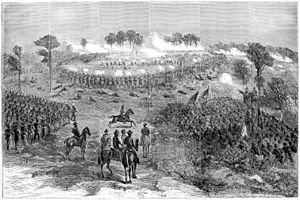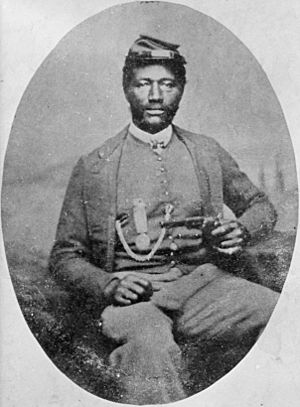Battle of Chaffin's Farm facts for kids
Quick facts for kids Battle of Chaffin's Farm and New Market Heights |
|||||||
|---|---|---|---|---|---|---|---|
| Part of the American Civil War | |||||||
 Union assault on Fort Harrison, September 29 (after a sketch by William Waud) |
|||||||
|
|||||||
| Belligerents | |||||||
| Commanders and leaders | |||||||
| Ulysses S. Grant Benjamin F. Butler |
Robert E. Lee Richard S. Ewell |
||||||
| Strength | |||||||
| 26,600 | 14,500 | ||||||
| Casualties and losses | |||||||
| 3,372 total 391 killed 2,317 wounded 649 missing/captured |
2,000 total 250 killed 1,250 wounded 500 missing/captured |
||||||
The Battle of Chaffin's Farm and New Market Heights was an important battle during the American Civil War. It happened in Virginia on September 29–30, 1864. This battle was part of a bigger plan by the Union Army to capture Petersburg and Richmond, the capital of the Confederacy. It is also sometimes called the Battle of Laurel Hill or the fights at Forts Harrison, Johnson, and Gilmer.
Contents
Why the Battle Happened
For a long time, the Confederate soldiers had built strong defenses around Richmond. By 1864, these defenses included a system of forts and trenches. One key area was Chaffin's Farm, near the James River.
In the summer of 1864, Union General Ulysses S. Grant tried to attack these defenses. His goal was to make the Confederates move their soldiers away from Petersburg. If he could cut off the supply lines to Petersburg, both Petersburg and Richmond would be in danger.
Grant had already tried this strategy twice before, in July and August. These earlier battles, known as the First Battle of Deep Bottom and Second Battle of Deep Bottom, didn't break through the Confederate lines. However, they did force Confederate General Robert E. Lee to move his troops. This helped the Union Army in other areas.
In late September, Grant planned another big attack. He wanted to cut the railroad supply lines south of Petersburg. To do this, he needed to distract General Lee. So, he ordered the Army of the James, led by General Benjamin Butler, to attack Richmond's defenses.
General Butler came up with a new plan. Instead of attacking the same old spots, he decided to surprise the Confederates. His army would cross the James River and attack two main points: New Market Heights and Fort Harrison. Capturing New Market Heights would protect the side of his army attacking Fort Harrison. If they succeeded, they would then try to capture other forts closer to Richmond.
The Battle Begins
The battle started with two main attacks by the Union Army.
Fighting at New Market Heights
Union General David B. Birney led his X Corps towards New Market Heights. This area was defended by Confederate General John Gregg and his soldiers.
A group of United States Colored Troops (African American soldiers) bravely attacked the heights. They faced strong resistance and were pushed back. During this attack, a soldier named Christian Abraham Fleetwood showed great courage, which later earned him the Medal of Honor.
General Birney sent more troops, and they attacked again. This time, a division led by Alfred Terry managed to get around the Confederate left side. This helped turn the fight in the Union's favor. When the Confederates heard that Fort Harrison was also under attack, they pulled back to other forts. The Confederates at New Market Heights were outnumbered, but they fought hard, causing many Union casualties.
Capturing Fort Harrison
At the same time, another Union force, the XVIII Corps under General Edward Ord, attacked Fort Harrison. This fort was a very strong point in the Confederate defense.
The Union attack was led by General George J. Stannard. His soldiers ran across an open field and managed to reach the fort. After a short rest, they stormed the fort and captured it! The Confederate defenders quickly retreated to another line of defense. Sadly, General Hiram Burnham was killed during the attack, and the Union soldiers renamed the captured fort "Fort Burnham" in his honor.
After taking the fort, the Union soldiers became a bit disorganized. Many of their commanders were wounded or killed. General Ord himself was badly wounded while trying to organize his troops. This made it hard for the Union to push further towards Richmond. Confederate ironclad ships on the James River also stopped the Union advance.
General Robert E. Lee knew how important Fort Harrison was. He quickly brought 10,000 more soldiers from Petersburg to try and take it back. On September 30, Lee ordered a counter-attack on Fort Harrison, which was now defended by Union General Godfrey Weitzel. However, the Confederate attacks were not well-coordinated and were easily pushed back by the Union defenders.
What Happened Next
Just as General Grant had hoped, the fighting at Chaffin's Farm forced General Lee to move his soldiers. This helped the Union army south of Petersburg win another important battle, the Battle of Peebles's Farm.
After October, the fighting around Richmond and Petersburg turned into trench warfare. This meant soldiers dug long ditches and fought from them, which continued until the end of the war. The battles around Chaffin's Farm resulted in nearly 5,000 soldiers being killed, wounded, or captured on both sides.
Heroes of the Battle: Medal of Honor Recipients
Many soldiers showed incredible bravery during this battle. The following men received the Medal of Honor, the highest military award in the United States, for their actions at Chaffin's Farm:

- William H. Barnes
- Joseph H. Shea
- Powhatan Beaty
- Thomas Belcher
- James H. Bronson
- George A. Buchanan
- Nathan Huntley Edgerton
- Christian Fleetwood
- James Daniel Gardner
- James H. Harris
- Thomas R. Hawkins
- Alfred B. Hilton
- Milton M. Holland
- William Stone Hubbell
- Miles James
- Franklin Johndro
- Alexander Kelly
- Nathaniel A. McKown
- Robert A. Pinn
- Edward Ratcliff
- John Schiller
- Ebenezer Skellie
- Charles Veale
- William Laing
A painting called Three Medals of Honor by artist Don Troiani shows three Medal of Honor recipients from the 6th U.S. Colored Infantry Regiment. These heroes were Nathan Huntley Edgerton, Thomas R. Hawkins, and Alexander Kelly.
Preserving the Battlefield
Today, groups like the American Battlefield Trust are working to protect the land where this battle took place. They have helped save about 87 acres (0.35 square kilometers) of the battlefield so that future generations can learn about this important part of history.

